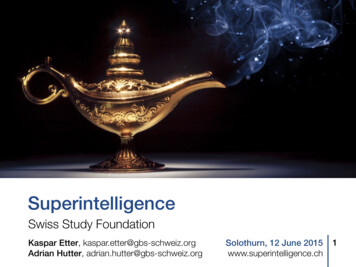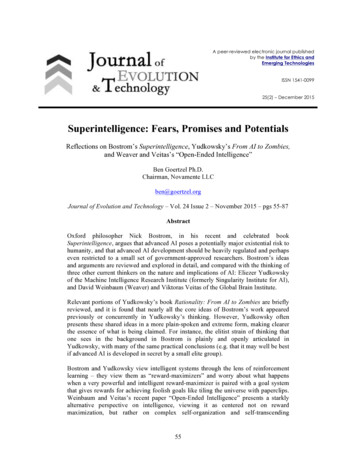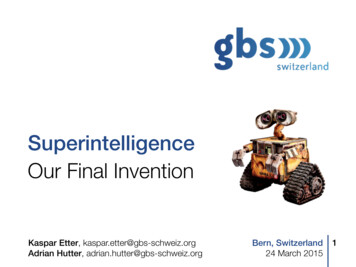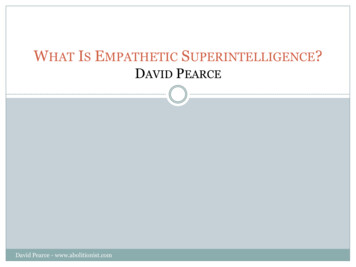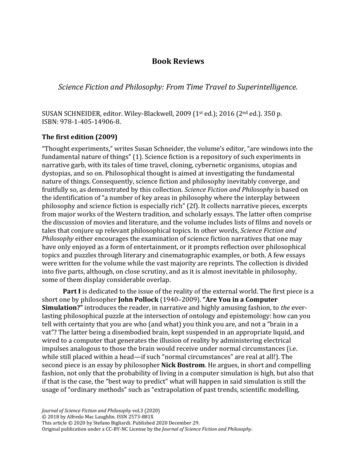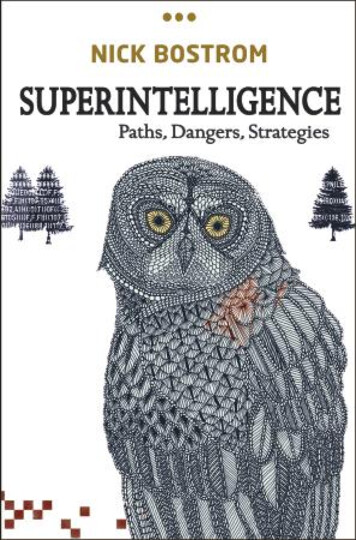
Transcription
Superintelligence
SUPERINTELLIGENCEPaths, Dangers, Strategiesnick bostromDirector, Future of Humanity InstituteProfessor, Faculty of Philosophy & Oxford Martin SchoolUniversity of Oxford1
1Great Clarendon Street, Oxford, OX2 6DP,United KingdomOxford University Press is a department of the University of Oxford.It furthers the University’s objective of excellence in research, scholarship,and education by publishing worldwide. Oxford is a registered trade mark ofOxford University Press in the UK and in certain other countries Nick Bostrom 2014The moral rights of the author have been assertedFirst Edition published in 2014Impression: 1All rights reserved. No part of this publication may be reproduced, stored ina retrieval system, or transmitted, in any form or by any means, without theprior permission in writing of Oxford University Press, or as expressly permittedby law, by licence or under terms agreed with the appropriate reprographicsrights organization. Enquiries concerning reproduction outside the scope of theabove should be sent to the Rights Department, Oxford University Press, at theaddress aboveYou must not circulate this work in any other formand you must impose this same condition on any acquirerBritish Library Cataloguing in Publication DataData availableLibrary of Congress Control Number: 2013955152ISBN 978–0–19–967811–2Printed in Italy byL.E.G.O. S.p.A.—Lavis TNLinks to third party websites are provided by Oxford in good faith andfor information only. Oxford disclaims any responsibility for the materialscontained in any third party website referenced in this work.
The Unfinished Fable of the SparrowsIt was the nest-building season, but after days of long hard work, the sparrowssat in the evening glow, relaxing and chirping away.“We are all so small and weak. Imagine how easy life would be if we had anowl who could help us build our nests!”“Yes!” said another. “And we could use it to look after our elderly and our young.”“It could give us advice and keep an eye out for the neighborhood cat,” addeda third.Then Pastus, the elder-bird, spoke: “Let us send out scouts in all directions andtry to find an abandoned owlet somewhere, or maybe an egg. A crow chick mightalso do, or a baby weasel. This could be the best thing that ever happened to us, atleast since the opening of the Pavilion of Unlimited Grain in yonder backyard.”The flock was exhilarated, and sparrows everywhere started chirping at the topof their lungs.Only Scronkfinkle, a one-eyed sparrow with a fretful temperament, was unconvinced of the wisdom of the endeavor. Quoth he: “This will surely be our undoing.Should we not give some thought to the art of owl-domestication and owl-tamingfirst, before we bring such a creature into our midst?”Replied Pastus: “Taming an owl sounds like an exceedingly difficult thing to do.It will be difficult enough to find an owl egg. So let us start there. After we have succeeded in raising an owl, then we can think about taking on this other challenge.”“There is a flaw in that plan!” squeaked Scronkfinkle; but his protests were invain as the flock had already lifted off to start implementing the directives set outby Pastus.Just two or three sparrows remained behind. Together they began to try to workout how owls might be tamed or domesticated. They soon realized that Pastus hadbeen right: this was an exceedingly difficult challenge, especially in the absenceof an actual owl to practice on. Nevertheless they pressed on as best they could,constantly fearing that the flock might return with an owl egg before a solution tothe control problem had been found.It is not known how the story ends, but the author dedicates this book toScronkfinkle and his followers.
PREFACEInside your cranium is the thing that does the reading. This thing, the humanbrain, has some capabilities that the brains of other animals lack. It is to thesedistinctive capabilities that we owe our dominant position on the planet.Other animals have stronger muscles and sharper claws, but we have clevererbrains. Our modest advantage in general intelligence has led us to develop language, technology, and complex social organization. The advantage has compounded over time, as each generation has built on the achievements of itspredecessors.If some day we build machine brains that surpass human brains in generalintelligence, then this new superintelligence could become very powerful. And,as the fate of the gorillas now depends more on us humans than on the gorillasthemselves, so the fate of our species would depend on the actions of the machinesuperintelligence.We do have one advantage: we get to build the stuff. In principle, we could builda kind of superintelligence that would protect human values. We would certainlyhave strong reason to do so. In practice, the control problem—the problem ofhow to control what the superintelligence would do—looks quite difficult. It alsolooks like we will only get one chance. Once unfriendly superintelligence exists,it would prevent us from replacing it or changing its preferences. Our fate wouldbe sealed.In this book, I try to understand the challenge presented by the prospect ofsuperintelligence, and how we might best respond. This is quite possibly the mostimportant and most daunting challenge humanity has ever faced. And—whetherwe succeed or fail—it is probably the last challenge we will ever face.It is no part of the argument in this book that we are on the threshold of a bigbreakthrough in artificial intelligence, or that we can predict with any precisionwhen such a development might occur. It seems somewhat likely that it will happen sometime in this century, but we don’t know for sure. The first couple of chapters do discuss possible pathways and say something about the question of timing.The bulk of the book, however, is about what happens after. We study the kineticsof an intelligence explosion, the forms and powers of superintelligence, and thestrategic choices available to a superintelligent agent that attains a decisive advantage. We then shift our focus to the control problem and ask what we could do toPR E FAC E vii
shape the initial conditions so as to achieve a survivable and beneficial outcome.Toward the end of the book, we zoom out and contemplate the larger picture thatemerges from our investigations. Some suggestions are offered on what ought tobe done now to increase our chances of avoiding an existential catastrophe later.This has not been an easy book to write. I hope the path that has been clearedwill enable other investigators to reach the new frontier more swiftly and conveniently, so that they can arrive there fresh and ready to join the work to furtherexpand the reach of our comprehension. (And if the way that has been made isa little bumpy and bendy, I hope that reviewers, in judging the result, will notunderestimate the hostility of the terrain ex ante!)This has not been an easy book to write: I have tried to make it an easy bookto read, but I don’t think I have quite succeeded. When writing, I had in mindas the target audience an earlier time-slice of myself, and I tried to produce akind of book that I would have enjoyed reading. This could prove a narrow demographic. Nevertheless, I think that the content should be accessible to many people, if they put some thought into it and resist the temptation to instantaneouslymisunderstand each new idea by assimilating it with the most similar-soundingcliché available in their cultural larders. Non-technical readers should not be discouraged by the occasional bit of mathematics or specialized vocabulary, for itis always possible to glean the main point from the surrounding explanations.(Conversely, for those readers who want more of the nitty-gritty, there is quite alot to be found among the endnotes.1)Many of the points made in this book are probably wrong.2 It is also likely thatthere are considerations of critical importance that I fail to take into account,thereby invalidating some or all of my conclusions. I have gone to some length toindicate nuances and degrees of uncertainty throughout the text—encumberingit with an unsightly smudge of “possibly,” “might,” “may,” “could well,” “it seems,”“probably,” “very likely,” “almost certainly.” Each qualifier has been placed whereit is carefully and deliberately. Yet these topical applications of epistemic modesty are not enough; they must be supplemented here by a systemic admission ofuncertainty and fallibility. This is not false modesty: for while I believe that mybook is likely to be seriously wrong and misleading, I think that the alternativeviews that have been presented in the literature are substantially worse—including the default view, or “null hypothesis,” according to which we can for the timebeing safely or reasonably ignore the prospect of superintelligence.viii P R E FAC E
ACKNOWLEDGMENTSThe membrane that has surrounded the writing process has been fairly permeable. Many concepts and ideas generated while working on the bookhave been allowed to seep out and have become part of a wider conversation; and, of course, numerous insights originating from the outside while thebook was underway have been incorporated into the text. I have tried to be somewhat diligent with the citation apparatus, but the influences are too many to fullydocument.For extensive discussions that have helped clarify my thinking I am grateful toa large set of people, including Ross Andersen, Stuart Armstrong, Owen CottonBarratt, Nick Beckstead, David Chalmers, Paul Christiano, Milan Ćirković, DanielDennett, David Deutsch, Daniel Dewey, Eric Drexler, Peter Eckersley, Amnon Eden,Owain Evans, Benja Fallenstein, Alex Flint, Carl Frey, Ian Goldin, Katja Grace,J. Storrs Hall, Robin Hanson, Demis Hassabis, James Hughes, Marcus Hutter,Garry Kasparov, Marcin Kulczycki, Shane Legg, Moshe Looks, Willam MacAskill,Eric Mandelbaum, James Martin, Lillian Martin, Roko Mijic, Vincent Mueller, ElonMusk, Seán Ó hÉigeartaigh, Toby Ord, Dennis Pamlin, Derek Parfit, David Pearce,Huw Price, Martin Rees, Bill Roscoe, Stuart Russell, Anna Salamon, Lou Salkind,Anders Sandberg, Julian Savulescu, Jürgen Schmidhuber, Nicholas Shackel, MurrayShanahan, Noel Sharkey, Carl Shulman, Peter Singer, Dan Stoicescu, Jaan Tallinn,Alexander Tamas, Max Tegmark, Roman Yampolskiy, and Eliezer Yudkowsky.For especially detailed comments, I am grateful to Milan Ćirković, DanielDewey, Owain Evans, Nick Hay, Keith Mansfield, Luke Muehlhauser, Toby Ord,Jess Riedel, Anders Sandberg, Murray Shanahan, and Carl Shulman. For adviceor research help with different parts I want to thank Stuart Armstrong, DanielDewey, Eric Drexler, Alexandre Erler, Rebecca Roache, and Anders Sandberg.For help with preparing the manuscript, I am thankful to Caleb Bell, MaloBourgon, Robin Brandt, Lance Bush, Cathy Douglass, Alexandre Erler, KristianRönn, Susan Rogers, Andrew Snyder-Beattie, Cecilia Tilli, and Alex Vermeer.I want particularly to thank my editor Keith Mansfield for his plentiful encouragement throughout the project.My apologies to everybody else who ought to have been remembered here.Finally, a most fond thank you to funders, friends, and family: without yourbacking, this work would not have been done.AC K N OW LE D G M E NT S ix
CONTENTSLists of Figures, Tables, and Boxes 1. Past developments and present capabilities Growth modes and big history Great expectations Seasons of hope and despair State of the art Opinions about the future of machine intelligence xv113511182. Paths to superintelligence 22Artificial intelligence 23Whole brain emulation 30Biological cognition 36Brain–computer interfaces 44Networks and organizations 48Summary 503. Forms of superintelligence Speed superintelligence Collective superintelligence Quality superintelligence Direct and indirect reach Sources of advantage for digital intelligence 5253545658594. The kinetics of an intelligence explosion 62Timing and speed of the takeoff 62Recalcitrance 66Non-machine intelligence paths Emulation and AI paths Optimization power and explosivity 666873CO NTE NT S xi
5. Decisive strategic advantage Will the frontrunner get a decisive strategic advantage? How large will the successful project be? Monitoring International collaboration From decisive strategic advantage to singleton 6. Cognitive superpowers Functionalities and superpowers An AI takeover scenario Power over nature and agents 7. The superintelligent will The relation between intelligence and motivation Instrumental convergence Self-preservation Goal-content integrity Cognitive enhancement Technological perfection Resource acquisition 787983848687919295991051051091091091111121138. Is the default outcome doom? 115Existential catastrophe as the default outcome of an intelligenceexplosion? 115The treacherous turn 116Malignant failure modes 119Perverse instantiation Infrastructure profusion Mind crime 9. The control problem Two agency problems Capability control methods Boxing methods Incentive methods Stunting Tripwires Motivation selection methods Direct specification Domesticity Indirect normativity Augmentation sis 143xii C O NTE NT S
10. Oracles, genies, sovereigns, tools 145Oracles 145Genies and sovereigns 148Tool-AIs 151Comparison 15511. Multipolar scenarios Of horses and men Wages and unemployment Capital and welfare The Malthusian principle in a historical perspective Population growth and investment 159160160161163164Life in an algorithmic economy 166Post-transition formation of a singleton? 176Voluntary slavery, casual death Would maximally efficient work be fun? Unconscious outsourcers? Evolution is not necessarily up A second transition Superorganisms and scale economies Unification by treaty 16716917217317717818012. Acquiring values 185The value-loading problem 185Evolutionary selection 187Reinforcement learning 188Associative value accretion 189Motivational scaffolding 191Value learning 192Emulation modulation 201Institution design 202Synopsis 20713. Choosing the criteria for choosing The need for indirect normativity Coherent extrapolated volition Some explications Rationales for CEV Further remarks Morality models Do What I Mean Component list Goal content 209209211212213216217220221222CO NTE NT S xiii
Decision theory Epistemology Ratification Getting close enough 14. The strategic picture Science and technology strategy Differential technological development Preferred order of arrival Rates of change and cognitive enhancement Technology couplings Second-guessing Pathways and enablers Effects of hardware progress Should whole brain emulation research be promoted? The person-affecting perspective favors speed boration 246The race dynamic and its perils On the benefits of collaboration Working together 15. Crunch time Philosophy with a deadline What is to be done? Seeking the strategic light Building good capacity Particular measures Will the best in human nature please stand up Notes Bibliography Index xiv C O NTE NT S246249253255255256257258258259261305325
LISTS OF FIGURES, TABLES,AND BOXESList of Figures1.2.3.4.5.6.7.8.9.10.11.Long-term history of world GDP. Overall long-term impact of HLMI. Supercomputer performance. Reconstructing 3D neuroanatomy from electron microscope images. Whole brain emulation roadmap. Composite faces as a metaphor for spell-checked genomes. Shape of the takeoff. A less anthropomorphic scale? One simple model of an intelligence explosion. Phases in an AI takeover scenario. Schematic illustration of some possible trajectories for a hypotheticalwise singleton. 12. Results of anthropomorphizing alien motivation. 13. Artificial intelligence or whole brain emulation first? 14. Risk levels in AI technology races. 3212731344163707796101106243247List of Tables1.2.3.4.5.6.7.8.Game-playing AI When will human-level machine intelligence be attained? How long from human level to superintelligence? Capabilities needed for whole brain emulation Maximum IQ gains from selecting among a set of embryos Possible impacts from genetic selection in different scenarios Some strategically significant technology races Superpowers: some strategically relevant tasks and correspondingskill sets 9. Different kinds of tripwires 10. Control methods 1219203237408194137143LI ST S O F F I G U R E S , TA B LE S , AN D BOXE S xv
11. Features of different system castes 12. Summary of value-loading techniques 13. Component list 156207222List of Boxes1.2.3.4.5.6.7.8.9.10.11.12.13.An optimal Bayesian agent The 2010 Flash Crash What would it take to recapitulate evolution? On the kinetics of an intelligence explosion Technology races: some historical examples The mail-ordered DNA scenario How big is the cosmic endowment? Anthropic capture Strange solutions from blind search Formalizing value learning An AI that wants to be friendly Two recent (half-baked) ideas A risk-race to the bottom xvi L I ST S O F F I G U R E S , TA B LE S , A N D BOXE S101725758098101134154194197198247
C H A P TE R 1Past developmentsand present capabilitiesWe begin by looking back. History, at the largest scale, seems toexhibit a sequence of distinct growth modes, each much morerapid than its predecessor. This pattern has been taken to suggestthat another (even faster) growth mode might be possible. However, we do notplace much weight on this observation—this is not a book about “technologicalacceleration” or “exponential growth” or the miscellaneous notions sometimesgathered under the rubric of “the singularity.” Next, we review the history ofartificial intelligence. We then survey the field’s current capabilities. Finally, weglance at some recent expert opinion surveys, and contemplate our ignoranceabout the timeline of future advances.Growth modes and big historyA mere few million years ago our ancestors were still swinging from the branchesin the African canopy. On a geological or even evolutionary timescale, the riseof Homo sapiens from our last common ancestor with the great apes happenedswiftly. We developed upright posture, opposable thumbs, and—crucially—somerelatively minor changes in brain size and neurological organization that led toa great leap in cognitive ability. As a consequence, humans can think abstractly,communicate complex thoughts, and culturally accumulate information over thegenerations far better than any other species on the planet.These capabilities let humans develop increasingly efficient productive technologies, making it possible for our ancestors to migrate far away from the rainforestand the savanna. Especially after the adoption of agriculture, population densities rose along with the total size of the human population. More people meantmore ideas; greater densities meant that ideas could spread more readily and thatsome individuals could devote themselves to developing specialized skills. TheseG ROW TH M O D E S AN D B I G H I STO RY 1
developments increased the rate of growth of economic productivity and technological capacity. Later developments, related to the Industrial Revolution, broughtabout a second, comparable step change in the rate of growth.Such changes in the rate of growth have important consequences. A few hundred thousand years ago, in early human (or hominid) prehistory, growth was soslow that it took on the order of one million years for human productive capacityto increase sufficiently to sustain an additional one million individuals living atsubsistence level. By 5000 bc, following the Agricultural Revolution, the rate ofgrowth had increased to the point where the same amount of growth took just twocenturies. Today, following the Industrial Revolution, the world economy growson average by that amount every ninety minutes.1Even the present rate of growth will produce impressive results if maintainedfor a moderately long time. If the world economy continues to grow at the samepace as it has over the past fifty years, then the world will be some 4.8 times richerby 2050 and about 34 times richer by 2100 than it is today.2Yet the prospect of continuing on a steady exponential growth path pales incomparison to what would happen if the world were to experience another stepchange in the rate of growth comparable in magnitude to those associated withthe Agricultural Revolution and the Industrial Revolution. The economist RobinHanson estimates, based on historical economic and population data, a characteristic world economy doubling time for Pleistocene hunter–gatherer society of 224,000 years; for farming society, 909 years; and for industrial society,6.3 years.3 (In Hanson’s model, the present epoch is a mixture of the farming andthe industrial growth modes—the world economy as a whole is not yet growing atthe 6 .3-year doubling rate.) If another such transition to a different growth modewere to occur, and it were of similar magnitude to the previous two, it would resultin a new growth regime in which the world economy would double in size aboutevery two weeks.Such a growth rate seems fantastic by current lights. Observers in earlierepochs might have found it equally preposterous to suppose that the world economy would one day be doubling several times within a single lifespan. Yet that isthe extraordinary condition we now take to be ordinary.The idea of a coming technological singularity has by now been widely popularized, starting with Vernor Vinge’s seminal essay and continuing with the writings of Ray Kurzweil and others.4 The term “singularity,” however, has been usedconfusedly in many disparate senses and has accreted an unholy (yet almost millenarian) aura of techno-utopian connotations.5 Since most of these meaningsand connotations are irrelevant to our argument, we can gain clarity by dispensing with the “singularity” word in favor of more precise terminology.The singularity-related idea that interests us here is the possibility of an intelligence explosion, particularly the prospect of machine superintelligence. Theremay be those who are persuaded by growth diagrams like the ones in Figure 1that another drastic change in growth mode is in the cards, comparable to theAgricultural or Industrial Revolution. These folk may then reflect that it is hard2 past de v elopments and present capabilities
(b)World GDP in trillions (2012 Int )454035302520151050–8000World GDP in trillions (2012 Int �2000Year1850Year19000195020002000Figure 1 Long-term history of world GDP. Plotted on a linear scale, the history of the worldeconomy looks like a flat line hugging the x-axis, until it suddenly spikes vertically upward. (a) Evenwhen we zoom in on the most recent 10,000 years, the pattern remains essentially one of a single90 angle. (b) Only within the past 100 years or so does the curve lift perceptibly above the zerolevel. (The different lines in the plot correspond to different data sets, which yield slightly differentestimates.6)to conceive of a scenario in which the world economy’s doubling time shortensto mere weeks that does not involve the creation of minds that are much fasterand more efficient than the familiar biological kind. However, the case for taking seriously the prospect of a machine intelligence revolution need not rely oncurve-fitting exercises or extrapolations from past economic growth. As we shallsee, there are stronger reasons for taking heed.Great expectationsMachines matching humans in general intelligence—that is, possessing common sense and an effective ability to learn, reason, and plan to meet complexinformation-processing challenges across a wide range of natural and abstractdomains—have been expected since the invention of computers in the 1940s. Atthat time, the advent of such machines was often placed some twenty years intogreat expectations 3
the future.7 Since then, the expected arrival date has been receding at a rate of oneyear per year; so that today, futurists who concern themselves with the possibilityof artificial general intelligence still often believe that intelligent machines are acouple of decades away.8Two decades is a sweet spot for prognosticators of radical change: near enoughto be attention-grabbing and relevant, yet far enough to make it possible to suppose that a string of breakthroughs, currently only vaguely imaginable, mightby then have occurred. Contrast this with shorter timescales: most technologiesthat will have a big impact on the world in five or ten years from now are alreadyin limited use, while technologies that will reshape the world in less than fifteenyears probably exist as laboratory prototypes. Twenty years may also be close tothe typical duration remaining of a forecaster’s career, bounding the reputationalrisk of a bold prediction.From the fact that some individuals have overpredicted artificial intelligence inthe past, however, it does not follow that AI is impossible or will never be developed.9 The main reason why progress has been slower than expected is that thetechnical difficulties of constructing intelligent machines have proved greaterthan the pioneers foresaw. But this leaves open just how great those difficultiesare and how far we now are from overcoming them. Sometimes a problem thatinitially looks hopelessly complicated turns out to have a surprisingly simple solution (though the reverse is probably more common).In the next chapter, we will look at different paths that may lead to human-levelmachine intelligence. But let us note at the outset that however many stops thereare between here and human-level machine intelligence, the latter is not the finaldestination. The next stop, just a short distance farther along the tracks, is superhuman-level machine intelligence. The train might not pause or even decelerateat Humanville Station. It is likely to swoosh right by.The mathematician I. J. Good, who had served as chief statistician in AlanTuring’s code-breaking team in World War II, might have been the first to enunciate the essential aspects of this scenario. In an oft-quoted passage from 1965, hewrote:Let an ultraintelligent machine be defined as a machine that can far surpass all the intellectual activities of any man however clever. Since the design of machines is one of theseintellectual activities, an ultraintelligent machine could design even better machines; therewould then unquestionably be an “intelligence explosion,” and the intelligence of manwould be left far behind. Thus the first ultraintelligent machine is the last invention thatman need ever make, provided that the machine is docile enough to tell us how to keep itunder control.10It may seem obvious now that major existential risks would be associated withsuch an intelligence explosion, and that the prospect should therefore be examined with the utmost seriousness even if it were known (which it is not) to have buta moderately small probability of coming to pass. The pioneers of artificial intelligence, however, notwithstanding their belief in the imminence of human-level4 past de v elopments and present capabilities
AI, mostly did not contemplate the possibility of greater-than-human AI. It is asthough their speculation muscle had so exhausted itself in conceiving the radicalpossibility of machines reaching human intelligence that it could not grasp thecorollary—that machines would subsequently become superintelligent.The AI pioneers for the most part did not countenance the possibility thattheir enterprise might involve risk.11 They gave no lip service—let alone serious thought—to any safety concern or ethical qualm related to the creation ofartificial minds and potential computer overlords: a lacuna that astonishes evenagainst the background of the era’s not-so-impressive standards of critical technology assessment.12 We must hope that by the time the enterprise eventually doesbecome feasible, we will have gained not only the technological proficiency toset off an intelligence explosion but also the higher level of mastery that may be necessary to make the detonation survivable.But before we turn to what lies ahead, it will be useful to take a quick glance atthe history of machine intelligence to date.Seasons of hope and despairIn the summer of 1956 at Dartmouth College, ten scientists sharing an interest in neural nets, automata theory, and the study of intelligence convened fora six-week workshop. This Dartmouth Summer Project is often regarded as the cockcrow of artificial intelligence as a field of research. Many of the participantswould later be recognized as founding figures. The optimistic outlook among thedelegates is reflected in the proposal submitted to the Rockefeller Foundation,which provided funding for the event:We propose that a 2 month, 10 man study of artificial intelligence be carried out. . . .The study is to proceed on the basis of the conjecture that every aspect of learning orany other feature of intelligence can in principle be so precisely described that a machinecan be made to simulate it. An attempt will be made to find how to make machines thatuse language, form abstractions and concepts, solve kinds of problems now reserved forhumans, and improve themselves. We think that a significant advance can be made in oneor more of these problems if a carefully selected group of scientists work on it togetherfor a summer.In the six decades since this brash beginning, the field of artificial intelligence hasbeen through periods of hype and high expectations alternating with periods ofsetback and disappointment.The first period of excitement, which began with the Dartmouth meeting, waslater described by John McCarthy (the event’s main organizer) as the “Look, Ma,no hands!” era. During these early days, researchers built systems designed torefute claims of the form “No machine coul
SUPERINTELLIGENCE Paths, Dangers, Strategies nick bostrom Director, Future of Humanity Institute Professor, Faculty of Philosophy & Oxford Martin School University of Oxford 1. 1 Great Clarendon Street, Oxford, OX2 6DP, United Kingdom Oxford University Press is a department of the University of Oxford.
